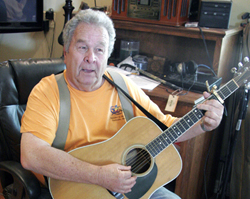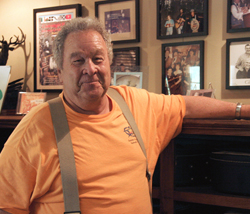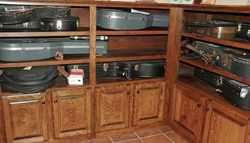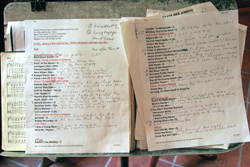Other Shreveport Articles
Cultural Preservation: Keeping the Flame Burning for Future Generations
Seasons and Cycles — Festivals and Rituals Mark Life's Rhythms
Of Hand and Heart: Handwork Connects Family and Community

Tunes and Tales Rekindle Celtic Roots: Bill Conly's Journey from Louisiana to Ireland
By Laura Marcus Green
Bill Conly's family has deep roots in the Ringgold area. Conly Road, leading to Bill's home, stretches under a canopy of Spanish moss and is paved with family history. Bill was always aware of his Irish and Scottish ancestry, but related culturally most strongly to his Louisiana home. In 1972, Bill's uncle, Etoyle Conly, and Dr. Garrie W. McGinty, a Louisiana Tech professor specializing in Irish history, co-authored a book about Cullen Thomas Conly, the family's immigrant ancestor. The publication, An Irish Stowaway, created a more direct link with Bill's cultural heritage.
As the story goes, Cullen Thomas Conly was around fifteen years old in the 1840s when the English took his horse for taxes. The young man decided to retrieve his horse by ambushing the British solders, but when his father caught wind of his son's plan he gave him a whipping. In response, Cullen Thomas Conly left home, never to return again. He stowed away on a ship bound for America, but was discovered during the journey. The custom at that time was to make stowaways work on board the ship during the remainder of the voyage and then return them home. As the ship approached the Savannah harbor in Georgia, Conly dove into the water and swam ashore, eluding a return trip to Ireland. He married in Savannah and set out for Texas, but ended up stopping in Louisiana. Conly established a cotton gin in the Ringgold area, and did well in the U.S., leaving his descendants a large parcel of land.
Over time, the family land has transitioned to keep up with times. Bill explains, "As I got a little older, my daddy saw cotton was a losing proposition no matter how you looked at it. So he finally started taking all our cotton land and letting it go into pasture and raising cattle on it instead. And a little bit of forest land." Bill notes that a lot of people went from cotton to cattle at that time. Between the boll weevils and the low price of cotton, the only people who could afford to raise cotton were those who lived on the bottomlands along the Red River, where the soil was rich. Bill's father sold his beef cattle at local auction barns, which were plentiful in the area at that time. Nowadays, few auction barns remain, as people have transitioned once again, this time from cattle to timber. Bill has embraced this change wholeheartedly, commenting "I never once had anybody call me at midnight to tell me my pine trees were out on the highway." Bill uses a rotation system to thin the timber on his land, which is mostly Loblolly pine, with some Short Leaf pine. His decision to put his land in timber fits well with his lifelong career as a forester.
Bill's musical abilities took root at the Springhill Baptist Church in Ringgold, where he has sung in the choir since he was a boy. His mother, who was of Scottish descent, was also in the church choir. She played the piano and sang, specializing in hymns and Southern style gospel. Bill remembers her beautiful alto voice and her love for singing harmony.
Growing up steeped in this music, he first learned to play guitar during his college years at Louisiana State University in the early 1950s, when rockabilly was becoming all the rage. As a teenager, Bill used to hear Elvis Presley play at the Shreveport Municipal Auditorium, when the King was a regular on the Louisiana Hayride radio show. Bill's college roommate taught him to play guitar and the two performed in a rockabilly band. Over the years, Bill learned to play old-time, bluegrass, and country music as well.
Bill vividly recalls the spark that kindled his love of Irish music, a passion that continues to burn brightly. He was invited to a party in Shreveport and asked to bring along his guitar. In attendance were three Irish nuns who were preparing to go home to Ireland for a vacation. Others were playing Irish music for the nuns' enjoyment, so Bill sang the handful of Irish songs he knew, which he had learned from Burl Ives records. The nuns must have sensed his talent and latent interest in Irish music. Returning from Ireland, they brought him a stack of Irish records, mostly by Tommy Makem and the Clancy Brothers. Listening to that foot-high pile of records, Bill taught himself to play Irish music. He began seeking out Irish music albums wherever he could find them and developing his repertoire.
At the time, Irish music was not common in northwest Louisiana. "Matter of fact," Bill recalls, "for a long time after I started learning those Irish songs, I really felt like I was the only human being in the whole United States that played and sang Irish music." Bill became a regular performer at the Natchitoches Folk Festival, where he learned about the North Texas Irish Festival in Dallas, Texas. When he first attended that regional festival, it was a revelation to Bill that there were others playing this music.
Bill's band, The Conlys, spans several decades. The original line-up included Bill's son, Bill Conly Jr. Although the band's personnel have changed over the years, Bill has kept the family name by which the band is known. Early on, the band played mostly on weekends, due to people's work schedules. When Bill retired after working 33 years as a forester for the Louisiana Forest Service in Bienville Parish, he was able to devote more time to his music. At that time, he played in three bands: Irish, bluegrass, and a Civil War-style group. In their heyday, the Conlys played throughout the region and beyond, from Oklahoma City to Key West. Bill fondly recalls the band's three-week tour to Iceland, where a former band member had relocated with her Air Force husband. These days, Bill and the band play out less frequently.
Through Etoyle Conly's research, the Louisiana Conlys ultimately made contact with their Irish kinfolk across the ocean. Cullen Thomas Conly was from Glen Orrin in northeastern Ireland. In 1990, Bill and his wife Louise traveled to Ballybay, Ireland in County Monaghan, where the family had moved in around 1900. While in Ireland, Bill not only connected with his Irish relatives, he also discovered the origins of a family tradition: telling tall tales, or "lying" as it's known in Louisiana. While in Slane, Ireland, Bill spent a memorable evening in a tavern, where he struck up a conversation with a gentleman at the bar. Bill shares his recollection:
I've always had a big appreciation for a bull shooter, somebody that could tell a good lie. And in Slane I was just setting there at that pub. Two guys [were] there, and this old guy, he wanted to talk to me. And he was one of the best liars I have ever seen in my life. You know, a bad liar would make himself the hero of everything. Well he didn't, he had his buddy there who was passed out most of the time, drunk. And he had elevated him to hero level. Joe was an officer in the IRA. Joe had the power of laying on hands and healing. Joe had been a POW in Laos, I think. And Joe'd been to Las Vegas. Now a bad liar would have had him winning a lot of money in Las Vegas, but he had Joe losing a quarter of a million dollars. And it got to be so much fun listening to those lies, I got to lying too. And boy, we was just throwing one lie at each other, we both just having a big time. Well this was craic to the hilt.
Craic is the Irish term for enjoyable conversation that might include news, gossip, or storytelling. Bill had not known the word before he visited Ireland, but, he says,
The good lying and the bull? Now that, I grew up with. Matter of fact, that's come in my family. That kind of talk, actually, I think that's totally come right straight directly through the Irish groove. My dad, my uncle, my cousins, we usually would be swapping stories and, you know, if there's anything to you, you can stretch it. There's nothing wrong with stretching it a little bit.
You know, there was no air conditioning and no television. We spent most of our times at night on the porch. I mean, unless it was cold weather. And people visited. Now, nobody does that. But yeah, we did, there was a lot of that. I remember, some of them would be maybe a full story, some of them maybe just a phrase that would catch me. I remember my daddy one time talking to another cousin there. And my daddy asked his cousin, this guy was a big fisherman, catfish fisherman. And my daddy asked him, says, 'Well don't your wife fish with you?' He said, 'My wife is just like her daddy. She don't fish and she don't like people that do fish.' But that type of thing was just constantly going on.
Bill has no doubt that there is a direct connection between lying in the American South among people of Scots-Irish descent and their ancestors from the home countries. "Just like that guy I was telling you about in Ireland. He fit it. Everything he was saying and doing was just like what I've heard all my life in Louisiana."
Not surprisingly, among the things Bill loves about Irish music is that most of the songs contain a complete story. He is especially drawn to sad songs and those that relate accounts of Irish history, as well as humorous songs. As a singer who is at home with multiple musical styles, Bill finds Irish songs distinctive for the power of their conviction. "There's no moderation, no in-between. It's either very sad, or if it's fighting songs it's very furious, fighting mad. Just, everything is done to the hilt. And a funny song, I mean they've got sarcasm. My God, the Irish invented sarcasm."
Along with his powerful and nuanced singing voice and guitar playing, Bill has played mandolin, banjo, pipes, and bodhran (an Irish drum). He has been a stalwart participant in Celtic music festivals throughout the Ark-La-Tex region and beyond, as his love of the music and the people who play it have taken him around the country to perform with his band. He is equally at home in a jam session, and loves this informal way of playing and connecting with other musicians. Jamming and playing with others has been a means of learning songs and making new friends. Bill has released numerous CDs of Irish music, bluegrass, and country music.
In addition to learning a sizeable repertoire of Celtic music, Bill has written quite a few Irish songs, as well as country and gospel ones. His trip to Ireland provided the inspiration for his song, "The Jealous Wall." The song tells the story of Robert Rochfort, the first Earl of Belvedere, who, suspecting his young wife of adultery, locked her up in a tower from which she was not released until his death. Fearing that his brother fancied his wife, Rochfort erected the Jealous Wall to block the view between the tower prison and his brother's mansion to the south. The song is the title track of a Conlys CD, the cover of which bears a haunting photo taken by Louise during their visit to the Belvedere House in County Westmeath. Bill has applied his love of a good tale to his songwriting. He reflects, "It's just the stories—even when I'm listening to a country song, I like songs with stories."






